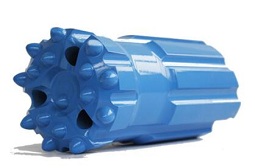DTH drilling tools are more energy-efficient as far less energy is lost in the transmission of force from the hammer to the drill bit. In top hammer drilling tools, some energy is lost via its path down the drill string. This continual pressure from the hammer on the rods and couplings of top hammer drilling tools strings wear those parts down over time, meaning that top hammer drilling tools require more replacement of consumables in the long run. Because the hammer is outside the hole while drilling, top hammer drilling tools make much more noise onsite than DTH drilling tools. While this noise can be reduced by adding a cab to a top hammer drill, this will increase the price. DTH drilling tools are much quieter as the repeated percussion of the hammer is located in the hole.
Top hammer drilling tools are well-suited to smaller, shallower holes (up to 20 m), drilling more quickly and efficiently than DTH drilling tools in such conditions. One drawback of DTH drilling tools is that they have a minimum hole diameter of about 3 ½ in, while top hammer drills can drill holes with diameters from 2 in. However, for much wider holes – even up to 30 m- DTH drilling tools can be used to create a pilot hole which can then be reamed further to the desired diameter.
The accuracy of top hammer drilling tools pales in comparison to the highly accurate DTH drilling tools but drill tubes can improve this and reduce the deviance of top hammer drilling tools. Top hammer drilling tools can also jam and lose a great deal of accuracy in hard rock, especially fractured hard rock, and are not recommended for this application. If you’re looking for accuracy at depth, especially in fractured hard rock, DTH drilling tools is the way to go.

Copyright © Guiyang Top Equipment All Rights Reserved
Sitemap | Powered by 